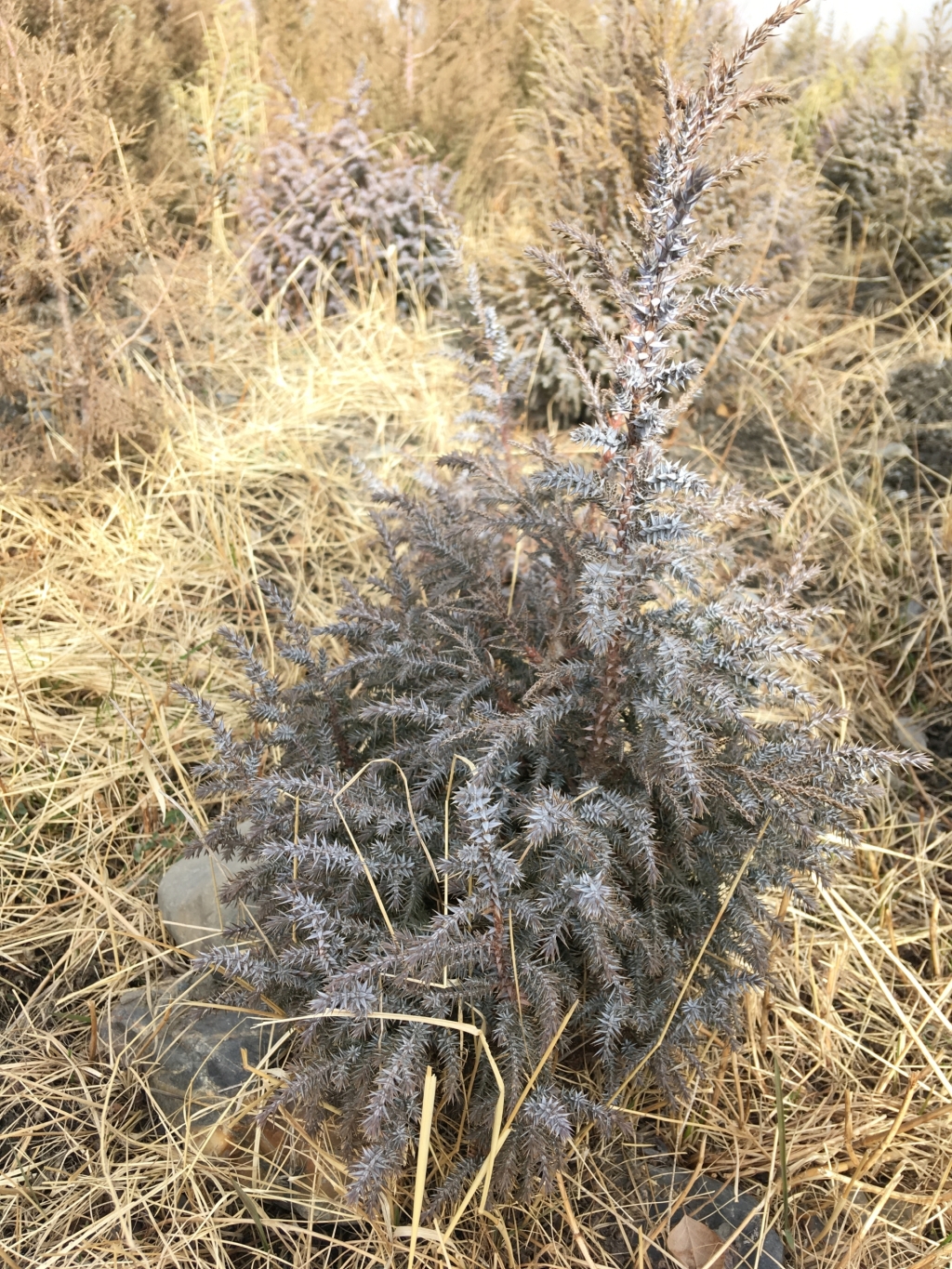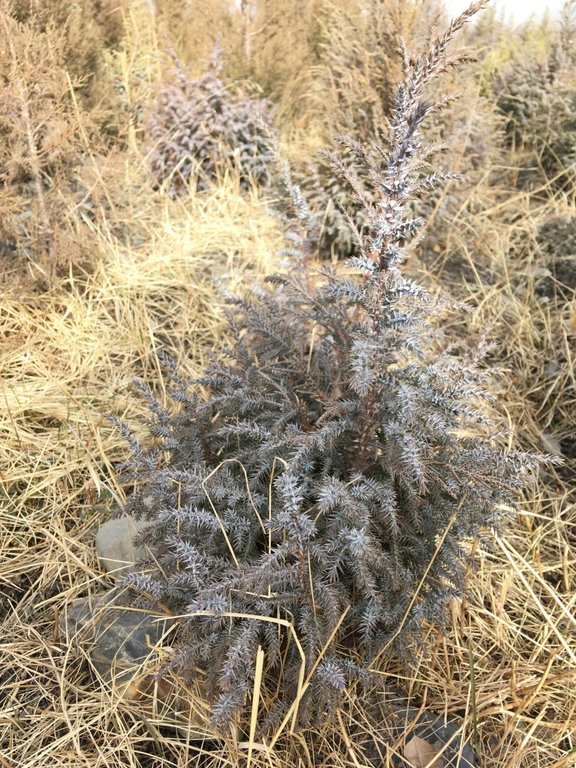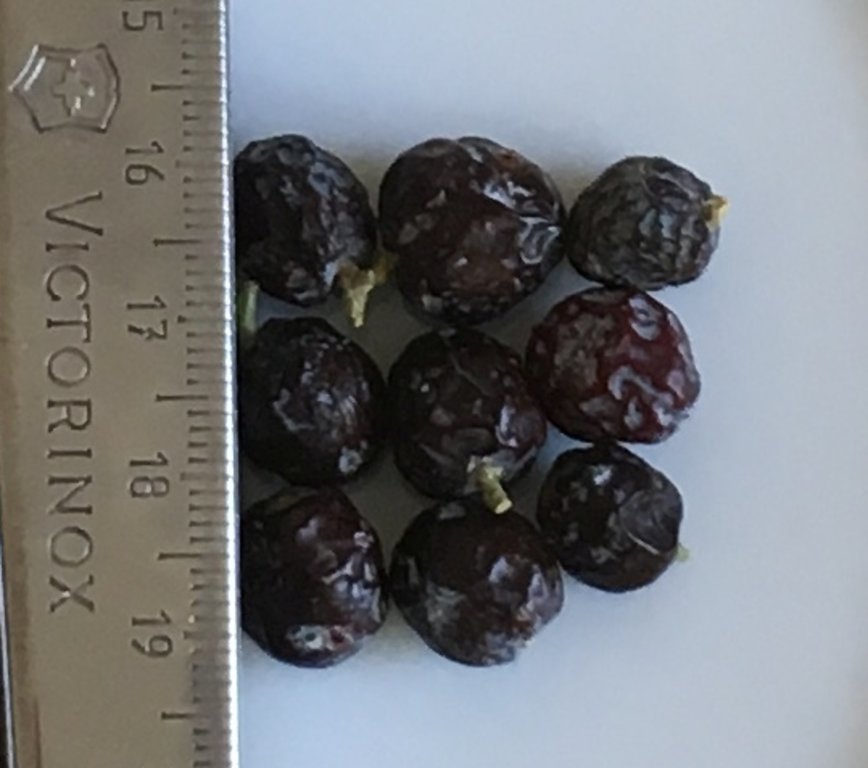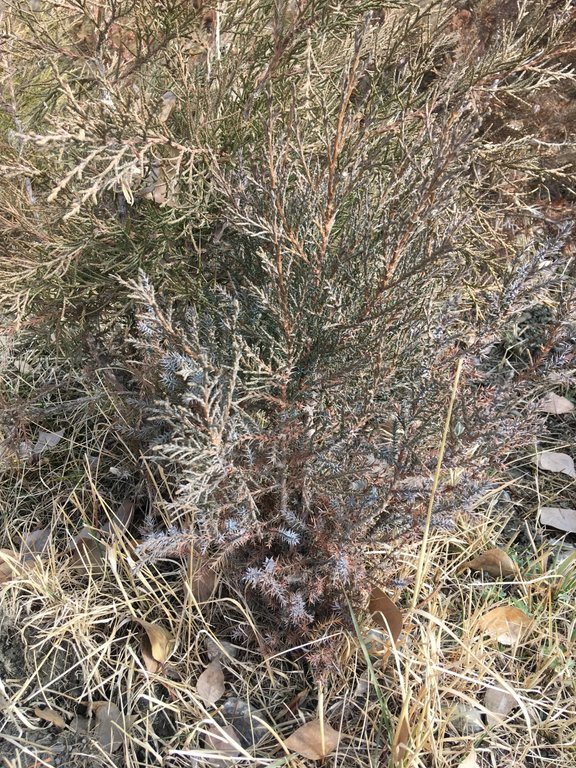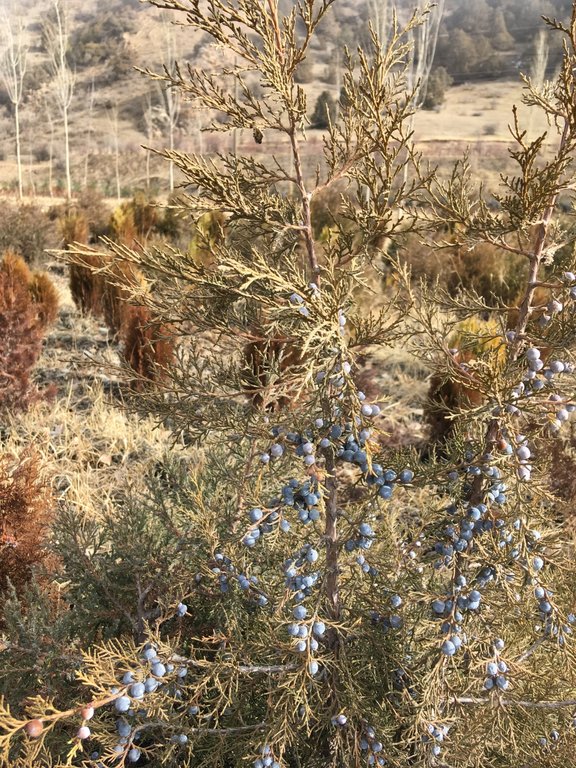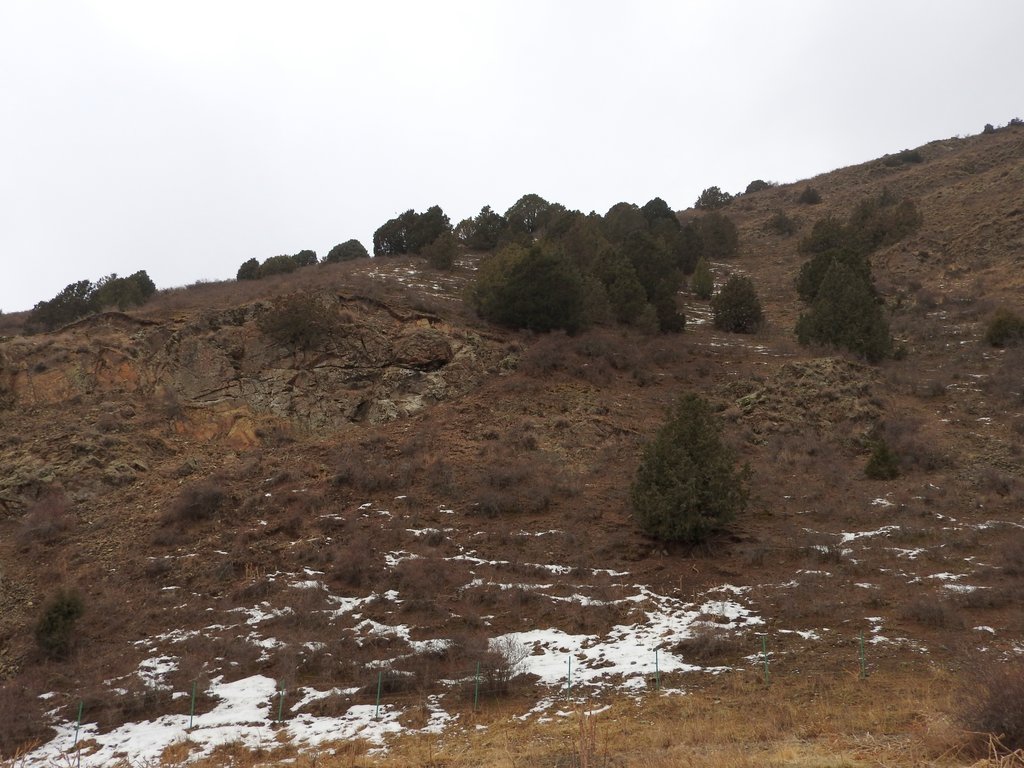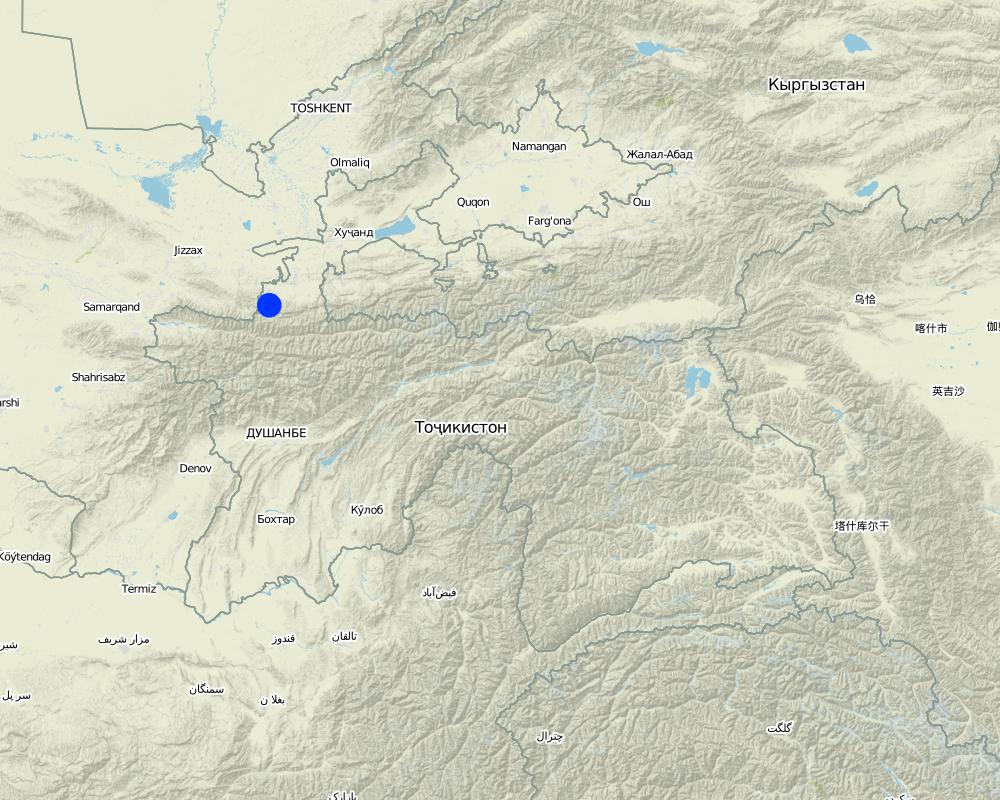Cultivation of local juniper species for rehabilitation of degrading woodland pastures [Тажикистан]
- Шинийг нээх:
- Шинэчлэх:
- Мэдээлэл цуглуулсан: Stefan Michel
- Редактор: –
- Хянагч: Umed Vahobov
Выращивание саженцев арчы для восстановления деградирующего редколесья горных пастбищ.
technologies_4295 - Тажикистан
Бүлгүүдийг үзэх
Бүгдийг харуулах Бүгдийг хаах1. Ерөнхий мэдээлэл
1.2 Технологийг үнэлэх, баримтжуулах ажилд хамаарах мэдээлэл өгсөн хүмүүс, байгууллагуудын холбоо барих мэдээлэл
Мэдээлэл өгсөн хүн (с)
Газар ашиглагч :
Shodiev Fakhriddin
Shahriston Forestry Enterprise
Тажикистан
Технологи баримтжуулах/үнэлэх ажилд дэмжлэг үзүүлсэн төслийн нэр (шаардлагатай бол)
Strengthening of Livelihoods through Climate Change Adaptation in Kyrgyzstan and TajikistanТехнологи баримтжуулах/үнэлэх ажилд дэмжлэг үзүүлсэн байгууллага(ууд)-ын нэр (шаардлагатай бол)
Deutsche Gesellschaft für Internationale Zusammenarbeit - Tajikistan (GIZ Tajikistan) - Тажикистан1.3 WOCAT-аар баримтжуулсан өгөгдлийг ашиглахтай холбоотой нөхцөл
Эмхэтгэгч болон гол мэдээлэгч хүн(хүмүүс) WOCAT аргачлалаар баримтжуулсан мэдээллийг ашиглахтай холбоотой нөхцлийг хүлээн зөвшөөрсөн.
Тийм
1.4 Технологи тогтвортой гэдгийг баталгаажуулах
Энэ технологи азрын доройтлыг бууруулахад нөлөө үзүүлэхгүй тул газрын тогтвортой менежментийн технологи болж чадахгүй юу?
Үгүй
1.5 ГТМ Арга барилын Асуулга (ууд) руу хандах (WOCAT ашиглан баримтжуулсан)
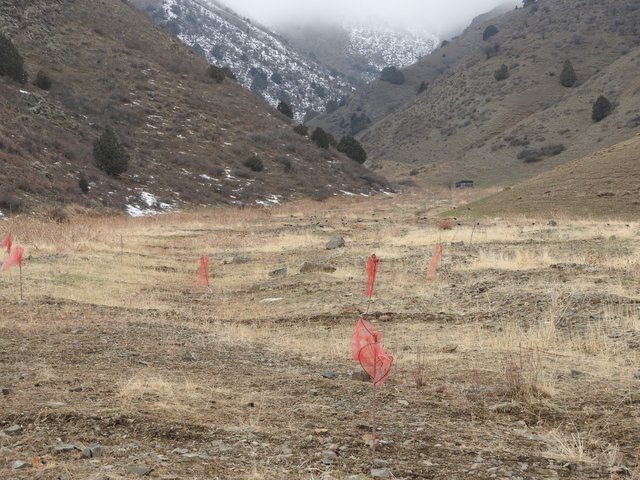
Disaster risk reduction and sustainable land-use by integrated … [Тажикистан]
A site affected by a debris flow was rehabilitated by joint communal work and integrated preventive measures addressing the upper catchment as well as the valley and the debris conus were implemented in collaboration of community, individual farmers, Committee of Emergency Situations and forestry enterprise.
- Мэдээлэл цуглуулсан: Stefan Michel
2. ГТМ Технологийн тодорхойлолт
2.1 Технологийн товч тодорхойлолт
Технологийн тодорхойлолт:
The local species of juniper trees (Juniperus seravschanica, Juniperus turkestanica and Juniperus semiglobosa) are rarely rejuvenating under conditions of intensive grazing and are difficult to propagate in nurseries. The technology describes the propagation of these important trees from locally collected seeds and their cultivation.
2.2 Технологийн дэлгэрэнгүй тайлбар
Тодорхойлолт:
The technology is used to produce seedlings of juniper trees in the forestry nursery for further replanting in the natural juniper woodlands of the local forestry enterprise. Juniper woodlands are important ecosystems of the mountains of Central Asia, which are typically used for livestock grazing. The tree cover fulfills important functions for the maintenance of ecosystem services – local microclimate, regulation of water infiltration and surface runoff, biodiversity, esthetic value and recreation, fuelwood etc. The local juniper species rarely rejuvenate naturally. Factors hampering natural rejuvenation include intensive grazing, competition by other plant species and weather conditions. Loss of old juniper trees due to natural losses, damage and cutting combined with lacking rejuvenation causes the degradation and loss of juniper stands. Forestry enterprises in Central Asia often in such situations instead of the difficult to cultivate and slowly growing native juniper often plant non-native arborvitae Thuja spec. These non-native species do not provide the natural ecosystem functions of native juniper and are less adapted to the local site conditions.
The purpose of the described technology is therefore the provision of planting material for the rehabilitation of degraded juniper woodland pastures with native trees.
Forestry workers collect ripe juniper fruits from their natural stands during late fall (November – December). The fruits are than mixed with sand and stored in a cold place until spring, or they are further processed to accelerate germination.
In the first case in spring the fruits are crushed on a clean concrete surface either by trampling with boots or by using a vehicle. Afterwards the crushed fruits are washed and air-dried. With the help of wind and a sieve the dried seeds are cleaned from other parts of the fruits. The seeds are then stored under a 5 cm layer of sand until fall and sown in fall (October-November)
In the second case the fruits are initially for one month stored in a barrel with water. Then the fruits are crushed and cleaned as described above. The cleaned seeding material will be stored in a pit, covered with moist sand mixed with some dung from horses or cattle. After one month the seeds are sown into the nursery.
In the area of the forestry enterprise brown bears feed on juniper fruits. In the bear feces many juniper seeds can be found, sometimes directly germinating. This “natural stratification” is sometimes used by forestry workers if they find substantial amounts of bear feces consisting of juniper fruits.
The seeds are sown directly into the soil in the nursery. Each, germination rate and survival are 90%. After five years the seedlings have grown to a height of about 20-30 cm, their roots reach 20 cm deep into the soil and they are ready for replanting.
The seedlings are carefully dug out, deep enough not to damage the root system and together with the earth covering the roots. They are wrapped in plastic bags for keeping the earth cover of the roots during transportation. During the planting the seedlings are put into the tree pits together with the soil from the nursery still covering the root system. The planted seedlings are watered.
After planting the seedlings are five years cared for, including weeding and if necessary watering either from a canal, if available, or with barrels.
The use of containers for seeding and replanting has not yet been tried. It may protect the root system during replanting and reduce the amount of soil to be used for this purpose. On the other hand the technology without containers is not dependent on their availability, no garbage in form of plastic containers is left in the tree pits and the larger amount of soil from the nursery may ease establishment of the seedlings at the woodland rehabilitation site.
2.3 Технологийн гэрэл зураг
2.5 Энэ үнэлгээнд хамрагдсан технологийг хэрэгжүүлсэн улс орон / бүс нутаг / байршил
Улс :
Тажикистан
Улс/аймаг/сум:
Sughd
Байршлын дэлгэрэнгүй тодорхойлолт:
Shahriston district; Shahriston Forestry Enterprise
Технологи өргөн дэлгэрсэн эсхийг тодорхойл:
- тодорхой газар хэрэгжсэн/ жижиг талбайд төвлөрсөн
Технологи(иуд) нэвтрүүлсэн талбай байнгын хамгаалалттай газар нутагт байрладаг уу?
Үгүй
Тайлбар:
The approximate locatoion of the nursery is indicated. The planting of produced seedlings takes place in different areas.
Map
×2.6 Хэрэгжих огноо
Байгуулсан тодорхой оныг мэдэхгүй бол баримжаа хугацааг тодорхойл:
- 10-50 жилийн өмнө
2.7 Технологийн танилцуулга
Технологийг хэрхэн нэвтрүүлснийг тодорхойл:
- Газар ашиглагчдын санаачилгаар
Тайлбар (төслийн төрөл г.м.):
The technology is implemented by Shahriston Forestry Enterprises since several decades.
3. ГТМ технологийн ангилал
3.1 Технологийн үндсэн зорилго (д)
- Газрын доройтлыг бууруулах, сэргийлэх, нөхөн сэргээх
- Экосистемийг хамгаалах
- Биологийн төрөл зүйлийг хамгаалах / сайжруулах
- Уур амьсгалын өөрчлөлт/ эрс тэс байдал болон түүний нөлөөлөлд дасан зохицох
- Нийгэмд үзүүлэх үр нөлөөг бий болгох
3.2 Технологи хэвтрүүлсэн газрын одоогийн газар ашиглалтын хэлбэр(д)
Нэг газр нутгийн хэмжээнд хэрэгжих холимог газар ашиглалт:
Тийм
Газар ашиглалтын холимог тогтолцоог (тарилан/бэлчээр/ой мод) тодорхойл:
- Сильво-пасторализм

Бэлчээрийн газар
Нүүдлийн бэлчээр ашиглалт:
- Хагас нүүдлийн бэлчээрийн аж ахуй
- Нүүдлийн бэлчээрийн мал аж ахуй
амьтдын төрөл зүйл:
- үхрийн аж ахуй - цагаан идээ
- үхрийн аж ахуй - махны чиглэлийн үхэр
- ямаа
- адуу
- хонь
Бүтээгдэхүүн ба үйлчилгээ:
- мах

Байгалийн ой / модтой газар
- (Сайжруулсан) байгалийн ой/мод бүхий газар
(Хагас)байгалийн ой/тармаг ойд: Менежментийн төрлийг тодорхойлно уу:
- Хатсан мод/мөчрийг авах
- Ойн дагалт баялаг ашиглах
(Хагас)байгалийн ойн төрөл:
- дундад өргөргийн уулт тогтолцооны байгалийн ургамалжилт
Дээр дурьдсан модны төрөл навч, шилмүүсээ гөвдөг үү эсвэл мөнх ногоон уу?
- холимог нөвч, шилмүүсээ гөвдөг/мөнх ногоон
Бүтээгдэхүүн ба үйлчилгээ:
- Түлшний мод
- Бусал ойн дагалт бүтээгдэхүүн
- Бэлчээрийн талбай/Хариулгатай бэлчээрлэлт
- Байгалийн нөөцийг хамгаалах
- Амралт, аялал жуулчлал
- Байгалийн гамшигаас сэргийлэх
3.3 Технологи хэрэгжүүлснээс газар ашиглалтад өөрчлөлт гарсан уу?
Технологи хэрэгжүүлснээс газар ашиглалтад өөрчлөлт гарсан уу?
- Үгүй (3.4 хариулт руу шилжинэ үү)
3.5 Технологи ГТМ-ийн аль бүлэгт хамаарах
- Байгалийн ба хагас-байгалийн ойн менежмент
- Бэлчээрийн мал аж ахуй ба бэлчээрийн газрын менежмент
3.6 Технологийг бүрдүүлэх ГТМ арга хэмжээ

Ургамалжилтын арга хэмжээ
- V1: Мод ба бут, сөөг

Менежментийн арга хэмжээ
3.7 Технологийн шийдвэрлэсэн газрын доройтлын үндсэн төрлүүд

Хөрс усаар эвдрэх

Биологийн доройтол
- Bc: Ургамлан нөмрөг багасах
- Bh: Амьдрах орчин доройтох
- Bq: Хэмжээ/ Биомасс буурах
- Bs: Ургамлын чанар, төрөл зүйл, олон янз байдал буурах
3.8 Газрын доройтлоос урьдчилан сэргийлэх, сааруулах ба нөхөн сэргээх
Газрын доройтолтой холбоотойгоор Технологи ямар зорилго тавьсан болохыг тодорхойл:
- Газрын доройтлоос урьдчилан сэргийлэх
- Газрын доройтлыг багасгах сааруулах
4. Техникийн нөхцөл, хэрэгжилтийн үйл ажиллагаа, материал ба зардал
4.3 Байгуулах үйл ажиллагаа
| Үйл ажиллагаа | Хугацаа (улирал) | |
|---|---|---|
| 1. | Collection of fruits from natural juniper stands | November-December |
| 2. | Stratification, cleaning of seeds | Winter - spring |
| 3. | Seeding | Winter or October-November |
| 4. | Replanting | Fall, five years after seeding |
| 5. | Watering, weeding | Each summer, up to five years |
Тайлбар:
Watering not always needed and/or possible. Often only once watered during first summer after replanting.
4.4 Байгуулалтад шаардагдах зардал ба материал
Тайлбар:
The technology is implemented in the frame of the regular activities of the state forestry enterprise. No calculation of costs was available during the time of the documentation.
4.5 Засвар үйлчилгээ / давтагдах үйл ажиллагаа
Тайлбар:
All maintenance activities (weeding, watering) are above indicated as establishment activities. After the planted juniper are established no further maintenance is required.
5. Хүн, байгалийн хүрээлэн буй орчин
5.1 Уур амьсгал
Жилийн нийлбэр хур тундас
- <250 мм
- 251-500 мм
- 501-750 мм
- 751-1,000 мм
- 1,001-1,500 мм
- 1,501-2,000 мм
- 2,001-3,000 мм
- 3,001-4,000 мм
- > 4,000 мм
Хур тунадасны талаархи тодорхойлолт/ тайлбар:
Rainfall is highly variable depending on altitude and aspect.
Суурь болгон авсан цаг уурын станцын нэр:
Shahriston (https://en.climate-data.org/asia/tajikistan/sughd-province/shahriston-28044/)
Агро-уур амьсгалын бүс
- Хагас чийглэг
- Хагас хуурай
Climate depends in altitude and aspect. At higher elevation and northern (eastern and western) aspect climate tends towards subhumid.
5.2 Байрзүйн зураг
Дундаж налуу:
- Тэгш (0-2 %)
- Бага зэрэг хэвгий (3-5 %)
- Дунд зэрэг хэвгий (6-10 % )
- Долгиорхог (11-15 %)
- Толгодорхог (16-30 %)
- Эгц налуу (31-60 % )
- Огцом эгц налуу (>60 %)
Гадаргын хэлбэр:
- Тэгш өндөрлөг/тэгш тал
- Зоо, хяр
- Уулын энгэр, хажуу
- Ухаа, гүвээ, дов толгод
- Уулын бэл
- Хөндий, хоолой, нам хотос
Өндөршлийн бүс:
- 0-100 м д.т.д
- 101-500 м д.т.д
- 501-1,000 м д.т.д
- 1,001-1,500 м д.т.д
- 1,501-2,000 м д.т.д
- 2,001-2,500 м д.т.д
- 2,501-3,000 м д.т.д
- 3,001-4,000 м д.т.д
- > 4,000 м д.т.д
Технологи дараах асуудалд хандсан эсэхийг тодорхойл:
- шаардлагагүй
Гадаргын талаархи тайлбар ба бусад тодорхойлолт:
Nursery at terrace of valley, woodlands at mountain slopes of varying steepness and altitudinal zones.
5.3 Хөрс
Хөрсний дундаж зузаан:
- Маш нимгэн (0-20 см)
- Нимгэн (21-50 см)
- Дунд зэрэг зузаан (51-80 см)
- Зузаан (81-120 cм)
- Маш зузаан (>120 cм)
Хөрсний бүтэц (өнгөн хөрс):
- Сийрэг/хөнгөн (элсэрхэг)
- Дунд зэрэг (шавранцар)
Өнгөн хөрсний органик нэгдэл:
- Их (>3 %)
- Дунд (1-3 % )
Боломжтой бол хөрсний бүрэн тодорхойлолт, боломжит мэдээллийг өгнө үү, жишээ нь хөрсний төрөл, хөрсний урвалын орчин/хүчиллэг байдал, катион солилцох чадавхи, азотын хэмжээ, давсжилт г.м.
Soil at nursery site may differ from conditions at the actual woodlands. Soil conditions in juniper woodlands can be very diverse.
5.4 Усны хүртээм ба чанар
Хөрсний усны гүн:
5-50 м
Гадаргын усны хүртээмж:
Дунд зэрэг
Усны давсжилт асуудал болдог уу?
Үгүй
Энэ газар үер усанд автдаг уу?
Үгүй
Усны чанар, нөөцийн талаархи тайлбар ба бусад тодорхойлолт:
Juniper typically grows in areas without ground water influence, but locally and where deforestation has not impacted the stands too much, juniper can also grow in riparian areas outside of the immediate influence of the river and subsoil water.
5.5 Биологийн төрөл зүйл
Зүйлийн олон янз байдал:
- Дунд зэрэг
Амьдрах орчны олон янз байдал:
- Дунд зэрэг
Биологийн олон янз байдлын талаархи тайлбар ба бусад тодорхойлолт:
Biodiversity in juniper woodlands varies depending on the specific type of vegetation and use intensity.
5.6 Технологи нэвтрүүлсэн газар ашиглагчидын онцлог шинж
Газар ашиглагчдын бусад шаардлагатай шинж чанарыг тодорхойл:
The land-user applying the technology is the state forestry enterprise.
5.7 Технологи нэвтрүүлэхэд газар ашиглагчийн ашигласан газрын дундаж талбай
- < 0.5 га
- 0.5-1 га
- 1-2 га
- 2-5 га
- 5-15 га
- 15-50 га
- 50-100 га
- 100-500 га
- 500-1,000 га
- 1,000-10,000 га
- > 10,000 га
Энэ нь жижиг, дунд, том оворт тооцогдох уу (орон нутгийн чиг баримжаагаар)?
- Бага-хэмжээний
Тайлбар:
Nursery is only few hectares. Woodland rehabilitation takes place in areas of several ten hectares each. The overall area belonging to the land use (forestry enterprise) is >10,000 ha.
5.8 Газар эзэмшил, газар ашиглах эрх, ус ашиглах эрх
Газар өмчлөл:
- Төр засаг
Газар ашиглах эрх:
- Түрээсийн хэлбэрээр
Газар ашиглалтын эрх уламжлалт эрхзүйн тогтолцоонд суурилдаг уу?
Үгүй
Тайлбар:
The forestry enterprise issues permits for seasonal use of juniper woodlands for livestock grazing by associations or individual livestock herders.
5.9 Дэд бүтэц, үйлчилгээний хүртээмж
Тайлбар:
Not relevant for this technology.
6. Үр нөлөө ба дүгнэлт
6.1 Технологийн талбай дахь үр нөлөө
Нийгэм-эдийн засгийн үр нөлөө
Усны хүртээм ба чанар
усалгааны усны хүртээмж
Нийгэм-соёлын үр нөлөө
амралт, нөхөн сэргээлтийн боломжууд
Экологийн үр нөлөө
Усны эргэлт/ илүүдэл
усны хэмжээ
ус хураах / цуглуулах
гадаргын урсац
ууршилт
Хөрс
хөрсний чийг
хөрсөн бүрхэвч
хөрс алдагдах
хөрсний органик нэгдэл/ хөрсөнд агуулагдах С
Биологийн: ургамал, амьтан
Ургамал бүрхэвч
газрын дээрхи / доорхи С
ургамлын төрөл, зүйл
амьтны төрөл, зүйл
амьдрах орчны олон янз байдал
Уур амьсгал болон гамшгийн эрсдлийг бууруулах
хөрсний гулсалт/ чулуун нуранги
бичил уур амьсгал
Талбай дахь буюу on-site үр нөлөөний үнэлгээг тодорхойлно уу (хэмжилт):
There are no scientific assessments of on-site impacts available. The assesment here represents a rough guess of impact of juniper woodland rehabilitation in moderately degraded pasture areas.
6.2 Технологийн талбайн гадна үзүүлсэн үр нөлөө
Усны хүртээмж
хуурай улиралд ашиглах найдвартай, тогтвортой урсгал
Доод урсгалын үер
урсацын адагт лаг шавар хуримтлагдана
хөрш зэргэлдээ газарт учирах хохирол
нийтийн/хувийн хэвшлийн дэд бүтцэд учируулах хохирол
Талбайн гадна буюу off-site үр нөлөөний үнэлгээг тодорхойлно уу (хэмжилт):
There are no scientific assessments of on-site impacts available. The assesment here represents a rough guess of impact of juniper woodland rehabilitation in moderately degraded pasture areas.
6.3 Технологийн уур амьсгалын өөрчлөлт ба Уур амьсгалаас хамаарах аюул/гамшигт үзэгдэлд өртөх байдал ба эмзэг байдал (газар ашиглагч нарын дүгнэлтээр)
Уур амьсгалын аажим өөрчлөлт
Уур амьсгалын аажим өөрчлөлт
| Улирал | Өсөх эсвэл буурах | Технологи түүний нөлөөг хэрхэн бууруулж байна? | |
|---|---|---|---|
| Жилийн дундаж температур | Өсөлт | Дунд зэрэг | |
| Улирлын температур | Хуурай улирал | Өсөлт | Дунд зэрэг |
| Жилийн дундаж хур тундас | Бууралт | Дунд зэрэг | |
| Улирлын хур тундас | Чийглэг/борооны улирал | Бууралт | Дунд зэрэг |
| Улирлын хур тундас | Хуурай улирал | Бууралт | Дунд зэрэг |
Тайлбар:
Juniper trees grow at sites with a broad range of climate conditions, some of them rather extreme. They can therefore expected to cope with increasing aridity and short-term extremes at their natural stands. In the nursery drought can be compensated by watering, although intensive watering may hamper adaptability and survival of replanted saplings.
6.4 Зардал ба үр ашгийн шинжилгээ
Үр ашгийг барилга байгууламжийн зардалтай (газар ашиглагчдын үзэл бодлоор) хэрхэн харьцуулах вэ?
Богино хугацаанд эргэн төлөгдөх байдал:
Дунд зэрэг
Урт хугацаанд эргэн төлөгдөх байдал:
Бага зэрэг эерэг
Үр ашгийг засвар үйлчилгээ/ урсгал зардалтай (газар ашиглагчдын үзэл бодлоор) хэрхэн харьцуулах вэ?
Богино хугацаанд эргэн төлөгдөх байдал:
Бага зэрэг эерэг
Урт хугацаанд эргэн төлөгдөх байдал:
Эерэг
Тайлбар:
Rehabilitation of juniper woodlands provides only long-term economic benefits. Costs of cultivation in nurseries are partly compensated by combined growing of decorative coniferous treees (thuja, spruce) for commercial sale.
6.5 Технологи нутагшуулах
- жишээ/ туршилт
6.6 Дасан зохицох
Хувьсан өөрчлөгдөж буй нөхцөл байдалд Технологид сүүлд ямар нэг шинэчлэл хийгдсэн үү?
Үгүй
6.7 Технологийн давуу тал/боломжууд
| Газар ашиглагчдын тодорхойлсон давуу тал/боломжууд |
|---|
| The technology is well established for the propagation of native juniper saplings and for the rehabilitation of juniper woodlands. |
| The technology has the advantage of allowing for the establishment/rehabilitation of tree stands with native species, which are adapted to local site conditions and are an integral component of the ecosystem. |
| The area of juniper woodlands in various stages of degradation in the country makes up many ten thousands of hectares. While resources (labour, nursery capacity) are prohibitive for replanting juniper in all areas, the technology allows for rehabilitation of key areas, identified by need and/or rehabilitation potential. In particular other forestry enterprises in the country with juniper woodlands could potentially adopt the technology. |
| Эмхэтгэгч, бусад мэдээлэл өгсөн хүмүүсийн өнцгөөс тодорхойлсон давуу тал/боломжууд |
|---|
| Same as land user's view. |
| Same as land user's view. |
| Same as land user's view. |
6.8 Технологийн дутагдалтай/сул тал/аюул болон тэдгээрийн хэрхэн даван туулах арга замууд
| Газар ашиглагч нарын тодорхойлсон сул тал/ дутагдал/ эрсдэл | Тэдгээрийг хэрхэн даван туулах вэ? |
|---|---|
| Substantial amount of work required. | Nothing suggested. |
| Juniper grows slower than other species. | Nothing suggested. |
| None mentioned |
| Эмхэтгэгч, бусад мэдээлэл өгсөн хүмүүсийн өнцгөөс тодорхойлсон сул тал/ дутагдал/ эрсдэл | Тэдгээрийг хэрхэн даван туулах вэ? |
|---|---|
| Same as land user's view. | Consider facilitation of natural rejuvenation through grazing management (temporary exclusion of sites or reduction of grazing intensity or adaptation of herd compostion - no goats). |
| Same as land user's view. | Natutral feature of the native juniper tree species, which cannot be changed, but needs to be taken into consideration during production of planting material and in the management of the woodlands. |
| Over grazing may hamper success of woodland recovery. | Support establishment of replanted saplings through grazing management (temporary exclusion of sites or reduction of grazing intensity or adaptation of herd compostion - no goats). |
7. Ном зүй ба холбоосууд
7.1 Мэдээллийн аргууд / эх сурвалжууд
- Хээрийн уулзалт, судалгаа
Site visit at nursery (November 2018), many site visits in juniper woodlands of Tajikistan and adjacent countries since 1993.
- Газар ашиглагчтай хийсэн ярилцлага
Interview with forest protection engineer of Shahriston Forestry Enterprise
- ГТМ-ийн мэргэжилтэн/шинжээчтэй хийсэн ярилцлага
Interview with forest protection engineer of Shahriston Forestry Enterprise, with GIZ experts Negmatjon Negmatov (agricultural expert) and Nodir Muhidinov (DRR expert).
- тайлан болон бусад эх сурвалжийн бүрдэл
Мэдээллийг хэзээ (газар дээр нь) цуглуулсан бэ?
27/11/2018
7.4 Ерөнхий мэдээлэл
The documentation of the technology is based on the site visit at the nursery and one single interview with the forest protection engineer of Shahriston Forestry Enterprise. It was not possible to observe the entire process of propagation, cultivation and replanting of juniper and to verify the recieved information. The compiler took into consideration additionally his ecological knowledge and expertise. Given the importance of juniper woodlands as ecosystems in Central Asia, their large-scale degradation, the difficulties of their rehabilitation and the prevalence of non-native species in reforestation projects this technology deserves documentation and further consideration.
Холбоос ба модулууд
Бүгдийг харуулах Бүгдийг хаахХолбоосууд

Disaster risk reduction and sustainable land-use by integrated … [Тажикистан]
A site affected by a debris flow was rehabilitated by joint communal work and integrated preventive measures addressing the upper catchment as well as the valley and the debris conus were implemented in collaboration of community, individual farmers, Committee of Emergency Situations and forestry enterprise.
- Мэдээлэл цуглуулсан: Stefan Michel
Модулууд
Модуль байхгүй байна


